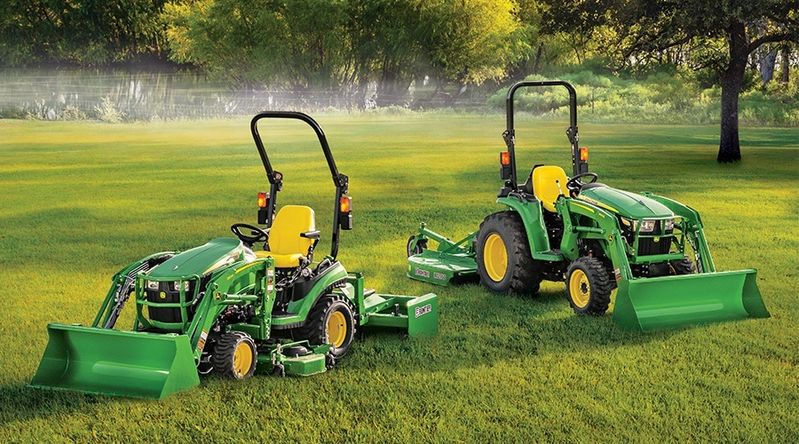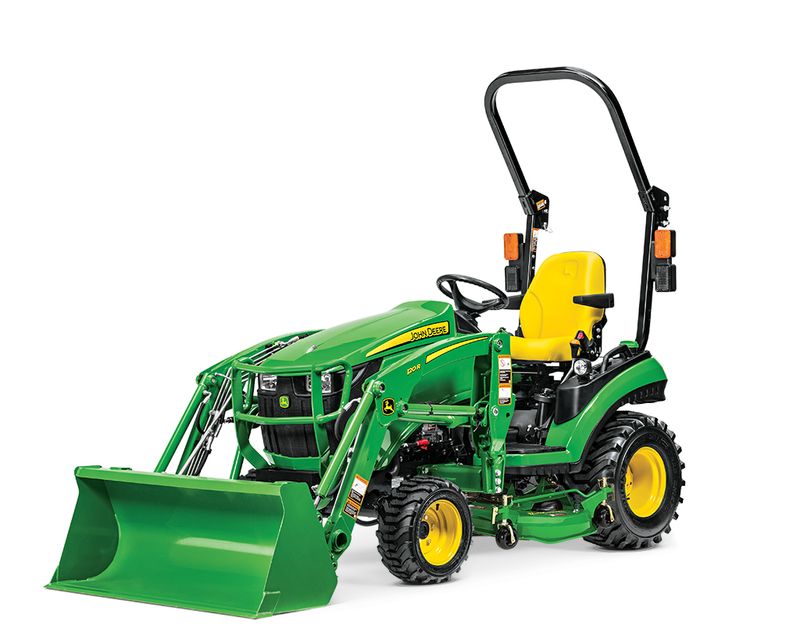
Utility Tractor Buying Guide
There are a lot of factors to take into consideration when buying a tractor. Price, condition, size, horsepower, attachments... the list goes on and on. We've put together this utility tractor buying guide to lead you through the process so you can make an informed purchase that won't come back to bite you.
Step 1: Decide what you want to accomplish
You're not just buying a tractor, you're investing in a tool for saving time, money, and effort. So ask yourself, "what do I want to do with this tractor?" Make a list of every chore, job, or project that comes to mind. Knowing what you want to do with a tractor will help you narrow in on the right size and options.
Here are some common tasks you might need to do:
- Clearing brush
- Mowing
- Driveway maintenance
- Building fences
- Removing stumps
- Landscaping
- Removing snow
- Harrowing
- Handling hay
Step 2: Choosing implements
Now that you know what you need your tractor to do, come up with a list of implements or attachments needed for each job. Loaders, box blades, rear blades, and mowers are the implements most commonly used.
Tip: Buy more tractor than you need. You may want to do more with your tractor in the future. Plan ahead so you don't limit yourself.
Which of these jobs are the most important to you? Pick 2 or 3 and you can quickly see which implements are essential. Next, write down some other requirements you might have based on those implements. For example, some may have a horsepower or 3-point hitch category requirement. Have a large property to maintain? You may want to step up a size to speed things up.
Loader requirements
If you need a loader, consider how high you'll need it to lift and how much weight it should hold. Are you stacking hay bales or moving gravel?
If you plan on removing your loader often, you may want a loader with an integrated park stand.
Tip: Some tractors have a single hydraulic pump that powers both the steering and implements. This can cause a reduction in power when doing loader work. All John Deere compact utility tractors include separate hydraulic pumps for steering and implements.
Mowing requirements
If you need to mow your lawn, you may want a lighter tractor with a mid-mount deck. A smaller tractor won't tear up the yard like a heavier tractor will, and the mid-mount deck will provide a cleaner cut. If you're mowing a 20 acre field, you may need a larger tractor with a rotary cutter to get the job done quicker.
Step 3: Features and specs
Size and weight
Before you buy a tractor, you need to make sure it can go everywhere you need it to. Measure your garage, fence posts, or other key areas to make sure it's going to fit. The weight of the tractor and type of tires can also leave a mark on your yard. If you plan to operate it on your front lawn, you may opt for a smaller tractor with some R3 (turf) or R4 (industrial) tires.
2WD vs 4WD
In general, you can't go wrong with a 4WD tractor. Four-wheel drive works better on hills, in wet ground conditions, and for loader work. Tractors with 4WD are more expensive, but they hold their value.
Two-wheel drive tractors are great for mowing, haymaking, hauling, and light tilling. For example, if you're growing tobacco, you'll probably need a small fleet of tractors just for transporting. You probably don't need 4WD, so you're going to save some money going with 2WD.
Tip: Four-wheel drive is an easy way to increase your tractor's capabilities without sizing up.
Transmission options
Depending on the jobs you're trying to do, the transmission can make a huge difference. Non-synchronized gear transmissions require you to come to a complete stop before clutching to change directions. If you'll be in forward gear most of the time, a non-synchronized transmission will work great and save you some money. If you're doing a lot of loader work or need to switch between forward and reverse often, a synchronized gear, shuttle, or hydrostatic transmission is best.
Shuttle transmissions have a second hand lever for changing directions without coming to a complete stop. Regular shuttle transmissions have to be clutched, but power shuttle transmissions will clutch automatically for you. Hydrostatic transmissions (HST) are the next step up. HSTs use one pedal (rocks back and forth to change directions) or two pedals (one for forward, one for reverse) for changing directions.
Comfort options
Comfort may not be your first priority when tractor shopping, but it should definitely be considered. If you're planning to run the tractor during multiple seasons for long periods of time, some comfort features will go a long way.
Adding a cab is the best way to stay comfortable. Heat, A/C, and protection from the elements will allow you to run year-round in all conditions. The cab comes with a price tag, but it's definitely worth it if you're a heavy user.
Cruise control is another important option to consider. If you'll be out in the field mowing for hours at a time, cruise control will make a huge difference.
What other comfort features are important to you? Ergonomic controls? High-back cushioned seat? The best way to find out what you like is to test drive one. Better yet, try out a few different models and compare what you liked or didn't like.
Step 4: Picking the one for you
By now you should have a pretty good idea of what you want to get out of your tractor. You know what implements you'll need, the specs required to do the work, and which features are important to you. Now it's choosing time.
Tractor manufacturers like John Deere have a way of classifying equipment based on the target customer. They're grouped together by power, size, and ability. Those classes are typically sub-compact, compact, and mid-size utility tractors. All brands are different, so we'll stick with John Deere to keep things simple.
Sub-compact utility tractors
Category includes John Deere 1-Series tractors: 1023E and 1025R.
Horsepower: 23 - 25 HP
Weight: 1,450 - 1,550 lbs (or up to 2,000 lbs with a cab)
Loader lift capacity: 550 - 750 lbs (at full height measured at 500 mm ahead of pivot (V))
Hitch Type: Limited Category 1
2WD or 4WD: 4WD
Compact utility tractors
Category includes John Deere 2-Series, 3-Series, and 4-series tractors.
Horsepower: 25 - 66 HP
Weight: 1,800 - 4,300 lbs (or up to 4,700 lbs with a cab)
Loader lift capacity: 800 - 2,250 lbs (at full height measured at 500 mm ahead of pivot (V))
Hitch Type: Limited Category 1, Category 1, or Category 2
2WD or 4WD: 4WD
Mid-size utility tractors
Category includes John Deere 5-Series and <140 HP 6-Series tractors.
Horsepower: 45 - 135 HP
Weight: 5,500 - 13,500 lbs
Loader lift capacity: 3,100 - 3,900 lbs (at full height measured at 800 mm ahead of pivot (V))
Hitch Type: Category 2 (convertible to Category 1) or Category 3N
2WD or 4WD: Both
In the market for a new utility tractor? Check out our compact and subcompact options or view our utility tractors. We also have a wide selection of used compact tractors and utility tractors. Need help finding the right one for you? Get in touch with the team at one of our stores. We're happy to answer any questions!


